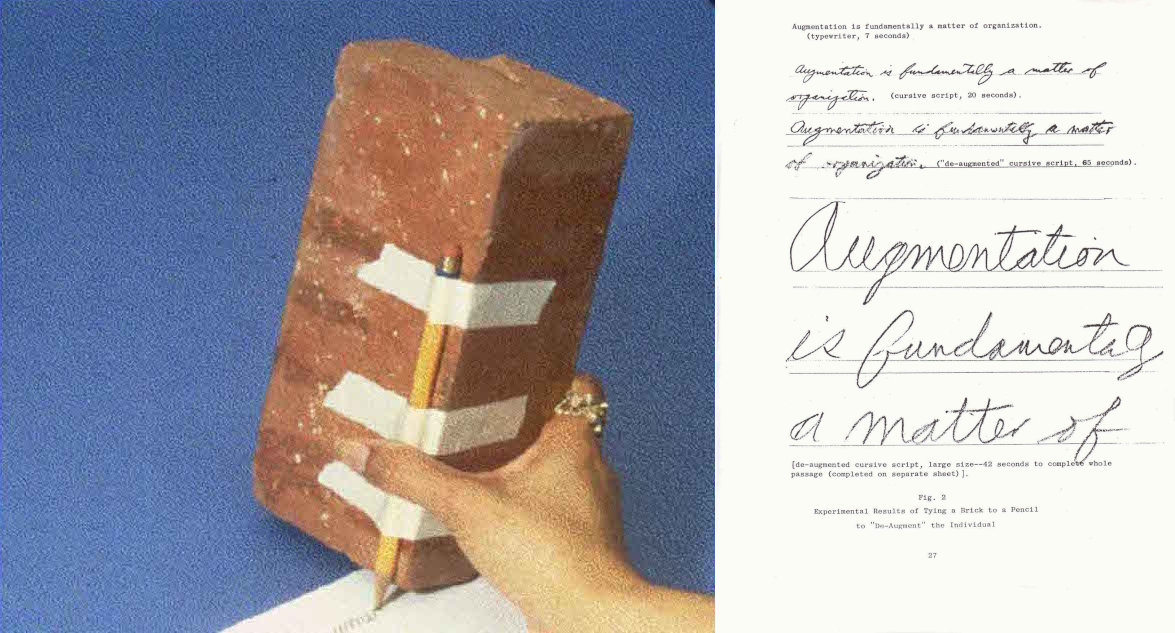getting rid of the brick
In 1962, Doug Engelbart taped a pencil to a brick and made some poor soul write with it.
The results were of course pitiful — and hilarious. The brick significantly impacted the ability to write, making it difficult to write even a single word. Some people even had to resort to writing larger letters to actually get the assignment done: they had to adapt themselves to the tool.
The obvious question would be: Who in their right mind would do that? Of course it’s a terrible idea to use a brick for writing!

But Engelbart did it to prove the point that tools influence the things we are able to do, and a bad tool interferes with doing things well.
When you make it harder to do the basic parts of an activity, the more advanced parts become almost impossible. In the case of the pencil and the brick, the participants spent so much effort on being able to write a single letter, they had none to spare on writing well: exploring ideas, structuring thoughts, and distilling them down to the essential.
Tools don’t only make things easier: they allow us to augment ourselves to do things that were previously impossible, to help us make our lives better.
Of course, the opposite is true as well. Bad tools interfere with us doing those things. In fact, they might even prevent us from doing anything at all.
Before people could write, we could only learn what we experienced directly, or were told by others. Writing changed all that: it allowed us to collect knowledge, improve it, and pass it on. The printing press helped transform the Middle Ages into a scientific society, not just by making books more available, but by changing the thought patterns of those who learned to read.
Computers have the unique potential to extend our intellect, our thinking, and our reasoning — and amplify them. Computers could allow us to expand our understanding of the world, to collaborate, and to address complex global crises.
But I don’t believe this is the path we’re on. Looking at the blind faith in technology, instead of a co-evolution between technology and culture, pushing each hype cycle to the absolute maximum only to replace by the next one when it fails to deliver on its promises, instead of thinking what is actually needed, still relying on pencil-and-paper-thinking instead of thinking about what a dynamic medium could look like, joining the social media “influencer” craze instead of having the difficult discussions about what world we want to live in, or re-inventing the wheel with each new app instead of going after approaches rooted in systems thinking…
I think we invent brick after brick, dampening our creativity and discouraging our understanding of the world.
Instead of creating a bicycle for the mind we’re creating bricks for the mind. We are amputating our intellect instead of extending it.
And the thing that boggles my mind most is that we can’t see the brick we’re using every day. Somehow, we just accept the tedious, cumbersome, and straining way we work with computers every day. We accept it as our reality. And then we boast about the incremental improvements and we’re happy that it is a little bit better. But it’s still a brick!
How can you not become thoroughly dissatisfied with the limitations of every modern computer, especially if you read about the history of computing? How can you not be completely frustrated with how little current technology helps us to collaborate effectively, change the way we think, or approach complex, global problems?
Probably the most important thing I can ask of you today is to try and understand that computing does not have to be the way it is. There’s a better version of computing out there, just waiting to be discovered.
The solutions for the complex, global problems we’re facing today, and in the future, come from the insights and abilities of people working together. It’s not the computer working alone that comes of up with solutions, nor is it individuals. It is the collaboration of people, augmented by computers.
The tools, and their interfaces, matter more than anything else. Unfortunately, many technologists greatly underestimate this problem, regarding it as a simple matter of making them look pretty or easy to use. But tools don’t change the world. People change the world by using tools. The focus must be on the use of the tool and not on the tool.
And getting rid of the brick might be just the first step.
Want more ideas like this in your inbox?
My letters are about long-lasting, sustainable change that fundamentally amplifies our human capabilities and raises our collective intelligence through generations. Would love to have you on board.